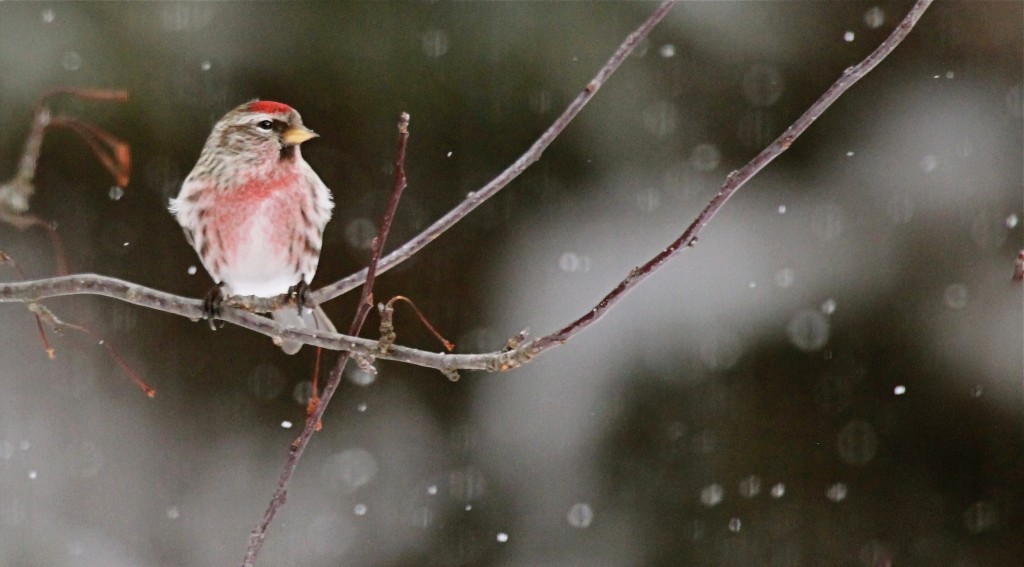This is a great time of year to start feeding the birds! Snow cover makes it more difficult for the birds to find food, and they need more energy to stay warm. I really think that feeding the birds helps us too- even on the most dreary and cold days we have colour, sound and movement in our back garden.
Bird feeding does not have to be complicated. If you were going to choose just one type of seed to put out, a good choice is black oil sunflower seed. This seed is attractive to a wide variety of birds such as the American Goldfinches (above), as well as Cardinals, Blue Jays, Sparrows, Chickadees, Nuthatches, Woodpeckers, and many more.

My feet are cold!
Black-Capped Chickadees are probably the most common and reliable visitors at my backyard feeders. They are so curious and active- and always the first ones to find a new feeder or pile of seeds I have put out. The photo above was taken on day 3 of the ice storm we had last December. I remember crunching out into the back garden to fill the feeders, and the little chickadees all flocking around me and calling out, so hungry for food that was not coated in a thick layer of ice.

Common Redpoll
Birds like Common Redpolls only come this far south some winters, but when they do they appreciate having a consistent source of food. They are such a beautiful raspberry red colour. I love it when they decide to visit. That’s the great thing about bird feeding- you never know who might arrive.

Fat and Happy Baby Woodpecker
Woodpeckers like sunflower seeds too, but their favourites are suet and peanuts. Once you start feeding the birds, it is fun to try different foods to see who you can attract.
My favourite place to find feeders, seed, and advice is The Bird House Nature Store in Wooler. Connie can answer all kinds of questions, give you advice, and get you started on a lifetime of setting the table for wildlife in your backyard. Then all you have to do is wait, and see who shows up!
You never know what you will see when you look out the window. Last winter we had a thick layer of snow and ice for an extended period of time, and a beautiful male Ring-Necked Pheasant fed on the ground under our feeders for a few weeks. Later in the spring, he found a mate and they raised a family. If our feeders had anything to do with his winter survival, I am glad of that.

Oooh my I’m full!
Of course, it’s not just birds that your feeder will attract! Chipmunks and squirrels love to come stock up at my feeders too.

Ready for Action – Red Squirrel
Some people try to wage battle with the squirrels and chipmunks, buying rodent- proof bird feeders, baffles, and using all kinds of other deterrence techniques. I have always just put out more than one feeder (OK, I have 12) and let everyone share. Buying feeders with metal feeding ports will save your feeders from being chewed and ruined by critters looking to make bigger holes. You can also just get feeders like platform or silo feeders that the squirrels can eat from easily without wrecking.
I’m really not sure, but having all the squirrels and chipmunks around may have had something to do with the fact that a Great Gray Owl roosted in our garden more than once last winter. What I do know is that the activity around our feeders attracts all kinds of action of one kind or another throughout the year.
If you invite wildlife onto your property, it will come, and you will have the chance to observe your own surprises out the window, even in the middle of winter.







As always…a totally enjoyable story…
Enjoy the pictures so much! Thanks for sharing Leslie. Great to share the Birdhouse link as well! 🙂
Thanks Maureen- waiting for your next wonderful batch of travel photos!
Since my visit to your gallery display I have enjoyed and look forward to your blogs. Great compositions…in both photography and writing.
Thank you so much! I enjoy it!